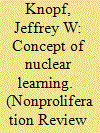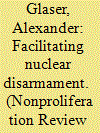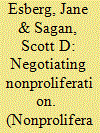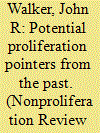|
|
|
Sort Order |
|
|
|
Items / Page
|
|
|
|
|
|
|
| Srl | Item |
| 1 |
ID:
111129


|
|
|
|
|
| Publication |
2012.
|
| Summary/Abstract |
In reply to Ward Wilson's response, the author notes that Wilson's current position about the effectiveness of nuclear deterrence is relatively agnostic compared to his original essay and that he now uses a much finer brush to define his qualms about nuclear deterrence. The perfectibility, rather than the existence of nuclear deterrence, is the paramount issue. The author also contends that in remaining fixated on civilian deaths and using Hiroshima and Nagasaki as his litmus test, Wilson fails to adequately consider whether there are other potential nuclear harms-fundamentally different in scale, scope, and moral and existential ramifications-that potentially can terrify societies enough to make nuclear deterrence a perfect or nearly perfect mode of security.
|
|
|
|
|
|
|
|
|
|
|
|
|
|
|
|
| 2 |
ID:
111130


|
|
|
|
|
| Publication |
2012.
|
| Summary/Abstract |
This article seeks to elucidate the concept of nuclear learning. It explores both the "nuclear" and the "learning" aspects of the concept. On the nuclear side, it distinguishes between learning basic facts about nuclear arms and drawing inferences about the larger implications of those facts. On the learning side, it discusses three issues: whether to use the term in a normative or value-neutral manner; the difference between learning that leads to a change in means versus learning that leads to a re-evaluation of ends; and whether learning only takes place at the level of individuals or whether there can also be learning by collective entities. The article argues there is no universal best answer to these questions and that the particular concept of learning that should be employed depends on the goals of the analyst. If the goal is to reduce the chances of nuclear war, however, one type of learning that will be important to consider is whether there is shared, cross-national learning.
|
|
|
|
|
|
|
|
|
|
|
|
|
|
|
|
| 3 |
ID:
111128


|
|
|
|
|
| Publication |
2012.
|
| Summary/Abstract |
Responding to Derrin Culp's critique, the author argues that distinguished nuclear theorists may be wrong because groups of experts have been wrong in the past, that city attacks are central to nuclear deterrence theory because killing civilians en masse is what nuclear weapons do best, and that understanding how effective city attacks would be in war is crucial to understanding how well they would work as threats. Moreover, while it is undeniable that nuclear deterrence works some of the time, this simply is not good enough. Because any failure of nuclear deterrence could end in catastrophic nuclear war, nuclear deterrence must be perfect or almost perfect. This is a very difficult standard to reach.
|
|
|
|
|
|
|
|
|
|
|
|
|
|
|
|
| 4 |
ID:
111127


|
|
|
|
|
| Publication |
2012.
|
| Summary/Abstract |
Several years ago, Ward Wilson presented in this journal a wide-ranging challenge to what every generation of national security scholars and practitioners since the end of World War II has been taught about nuclear weapons. He asserted that nuclear deterrence amounts to far less than its proponents have claimed and provocatively suggested that nuclear deterrence is a myth. Relying upon both empirical and theoretical objections to nuclear deterrence, he concluded that its failures were clear-cut and indisputable, whereas its successes were speculative. Yet in spite of a flourishing trade in scholarly articles, think tank reports, blog posts, and opinion pieces concerning nuclear deterrence, nobody-including nuclear weapons scholars-has ventured more than a limited critique of Wilson's essay. There are, however, serious shortcomings in Wilson's arguments-deficiencies that make his essay an unpersuasive brief against nuclear deterrence. Wilson's thesis could be correct. His arguments, however, are unlikely to persuade any skeptical members of Congress, upon whom future progress in arms control depends, to reconsider the value they attach to nuclear weapons and nuclear deterrence.
|
|
|
|
|
|
|
|
|
|
|
|
|
|
|
|
| 5 |
ID:
111133


|
|
|
|
|
| Publication |
2012.
|
| Summary/Abstract |
Unprecedented interest in seeking progress toward nuclear disarmament exists today; even some nuclear weapon states are looking for new ways to strengthen this process. National declarations of fissile material holdings-highly enriched uranium and plutonium-could play an important role in supporting this effort, facilitating not only transparency but also the irreversibility of the process. This article discusses what kind of content such declarations could have in order to be meaningful and effective, the sequence of data on fissile material holdings that states might release, and some of the challenges to be expected in reconstructing historic fissile material production; it also summarizes current attitudes of weapon states toward making such declarations. Initial declarations can be valuable as confidence-building measures, but better and more background data are necessary if declarations are to serve as the groundwork for deeper cuts in the nuclear arsenals. A robust verification approach would ultimately require inspectors to have access to fissile material production and storage sites. The methods and tools of nuclear forensic analysis-in this context also dubbed nuclear archaeology-would be a key element of this process. This article discusses the capabilities and limitations of potential approaches to verifying declarations of historic production of plutonium and highly enriched uranium; it also identifies and discusses opportunities for further research and development.
|
|
|
|
|
|
|
|
|
|
|
|
|
|
|
|
| 6 |
ID:
111131


|
|
|
|
|
| Publication |
2012.
|
| Summary/Abstract |
In nuclear nonproliferation negotiations, many governments pursue multiple objectives, and changes in policy can occur rapidly-and often unexpectedly. For these reasons, understanding nonproliferation requires empathy and imagination rather than just historical fact. This article considers one teaching tool to encourage such insight-simulations-and demonstrates how teaching and scholarship can interact to improve our understanding of the complex decisions and negotiations involved in nuclear nonproliferation. The article consists of five parts: first, it explains the benefits of simulations as both a policy development tool in Washington and as a teaching tool in universities; second, it describes the pedagogical strategy of the Stanford University simulation program; third, it shows how the simulations have identified and highlighted theoretical and substantive insights that are often neglected in scholarly studies of nonproliferation; and fourth, it describes how students are tested to enhance the learning experience from the simulation. Fifth and finally, the article provides concluding observations about how using simulations in the classroom can help scholars develop insights that improve their understanding of real-world nuclear negotiation dynamics and outcomes.
|
|
|
|
|
|
|
|
|
|
|
|
|
|
|
|
| 7 |
ID:
111132


|
|
|
|
|
| Publication |
2012.
|
| Summary/Abstract |
Becoming a nuclear weapon state and sustaining a militarily credible nuclear weapons capability is far from trivial, especially for medium powers. Such a capability is demonstrated by much more than firing a first test or acquiring significant quantities of fissile material; capability is indicated by factors including weaponization, delivery of weapons, reliability and effectiveness of weapons and their delivery systems, fissile material availability, and nuclear and non-nuclear testing. Files in the British National Archives shed considerable light on the problems faced by the nuclear weapon program of the United Kingdom from 1952 through the late 1960s. The question is whether this experience is unique or if it instead offers insights into the potential problems faced by, or facing, other medium or aspiring nuclear weapon states. The proliferation-related topics highlighted include: fissile material production, nuclear testing, the first weapon, weapon delivery rates, non-nuclear testing, delivery platform problems, and long-term maintenance and capability sustainability. Further research could provide clearer insights.
|
|
|
|
|
|
|
|
|
|
|
|
|
|
|
|
| 8 |
ID:
111125


|
|
|
|
|
| Publication |
2012.
|
| Summary/Abstract |
Despite the fact that Italy hosts almost half of the remaining estimated 150-200 US tactical nuclear weapons (TNW) that are currently deployed in Europe, case studies of Italy have been largely neglected. The article seeks to fill that gap by outlining the key elements of Italy's position regarding the presence, role, and future of TNW in Italy. By considering both the military and political-symbolic dimensions of TNW, the author argues that Italy has largely embraced the process of the devaluation of nuclear weapons; however, this is offset by the country's determination to preserve the principles of solidarity and the indivisibility of Euro-Atlantic security. By making the alliance's cohesion a priority, Italy appears willing to postpone the complete elimination of TNW from its territory if necessary; despite this, Italy otherwise considers TNW to be not only weapons of little intrinsic value but also obstacles to the global nuclear disarmament program that it strongly supports.
|
|
|
|
|
|
|
|
|
|
|
|
|
|
|
|
| 9 |
ID:
111126


|
|
|
|
|
| Publication |
2012.
|
| Summary/Abstract |
Understanding why the Iranian regime wants to possess nuclear weapons is essential to formulating the best policy to prevent (or perhaps to simply manage) the emergence of a nuclear-armed Iran. Three general theories-realism, liberalism, and constructivism-provide a framework for looking at Iran's nuclear motivations. However, contrary to many analyses, the regime's desire to possess nuclear arms stems not from neorealist defensive concerns, but rather from offensive goals driven by domestic politics. The use of extremist Islamism by the Iranian regime to justify its autocratic rule is the primary motivating factor. Accordingly, the outlook for diplomatically addressing the Iranian regime's nuclear aspirations appears dim.
|
|
|
|
|
|
|
|
|
|
|
|
|
|
|
|
|
|
|
|
|